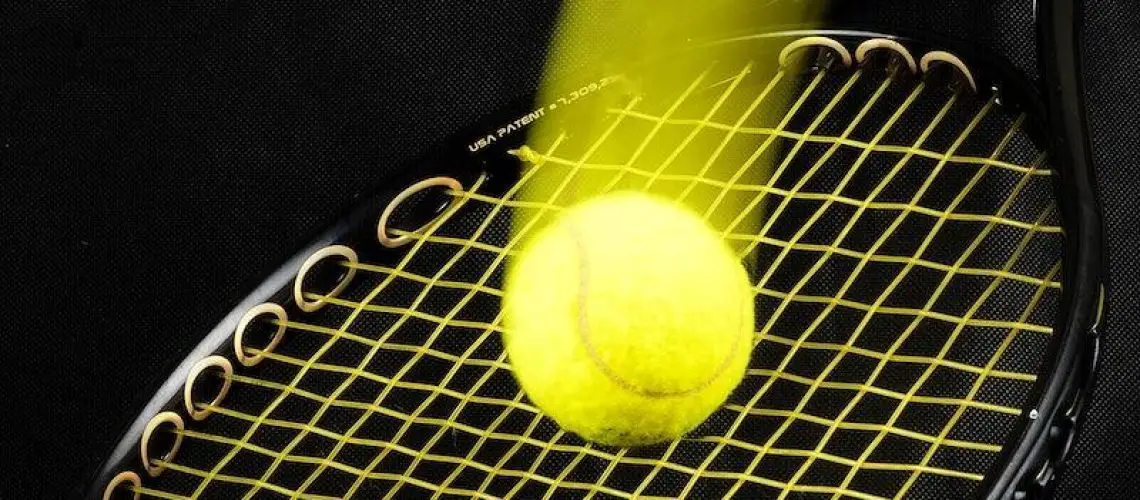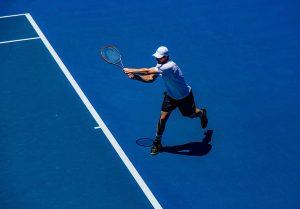We may earn money or products from the companies mentioned in this post.
Introduction

Welcome to the world of tennis, where the speed and accuracy of your serve can make all the difference in a match A fast serve is not only impressive to watch, but it can give you a tremendous advantage on the court Whether you’re a professional player aiming for that winning edge or an amateur looking to improve your game, mastering the art of serving fast is crucial
The Importance of a Fast Serve in Tennis
1 Significance for Professional Players:
For professional players, a fast serve is an indispensable weapon in their arsenal It allows them to control the tempo of the game, put pressure on their opponents, and gain immediate points A powerful serve can often secure free points or set up advantageous positions for subsequent shots
2 Benefits for Amateur Players:
While professional players may rely on their fast serves as a strategic advantage, amateurs can also reap significant benefits from developing this skill A strong serve not only adds excitement to your game but also gives you an upper hand against opponents who struggle to return high-speed shots Additionally, improving your serve can boost your confidence on the court and elevate your overall performance
The Purpose of This Blog Post: A Comprehensive Guide on How to Serve Fast in Tennis
In this comprehensive guide, we will delve into various techniques and strategies that will help you develop a lightning-fast serve From perfecting your stance and grip to generating explosive power through proper body mechanics, we’ll cover all aspects necessary for achieving maximum velocity and accuracy with each swing
So grab your racket and get ready! By following these expert tips and practicing diligently, you’ll be well on your way to serving like a pro in no time
Fundamentals of a Powerful Tennis Serve

When it comes to mastering the tennis serve, understanding the fundamental techniques is crucial The grip and racket positioning play a vital role in achieving power and control over your shots Two popular grip techniques are the Eastern backhand grip and the Continental grip
1 Eastern Backhand Grip Technique
The Eastern backhand grip involves placing your base knuckle on the third bevel of the racket handle This grip allows for more wrist snap, providing extra spin and control on your serve It is commonly used by players who favor topspin serves
2 Continental Grip Technique
The Continental grip, also known as the “chopper” grip, requires placing your base knuckle on or near the second bevel of the racket handle This grip offers versatility as it enables you to hit different types of serves, including flat, slice, and kick serves
In addition to proper gripping technique, mastering stance and body alignment are essential for a powerful tennis serve
1 Platform Stance vs Pinpoint Stance
Players have two main options when it comes to their serving stance: platform stance or pinpoint stance
-
Platform Stance:
In this stance, both feet are parallel to each other with a shoulder-width distance apart The advantage of this stance is stability and balance during the serve motion However, it may limit hip rotation and power generation -
Pinpoint Stance:
With this stance, one foot (usually the front foot) is positioned slightly ahead of the other foot The pinpoint stance allows for maximum hip rotation and generates more power in the serve but can be less stable compared to a platform stance
2 Ideal Body Positioning During the Initial Stage of Serving
During the initial stage of serving, it is crucial to achieve proper body positioning for an effective serve
-
Feet Placement and Weight Distribution:
Your feet should be aligned with your target, with the weight distributed evenly on both feet This ensures a stable base and facilitates efficient weight transfer during the serve -
Hips, Shoulders, and Chest Alignment:
Aligning your hips, shoulders, and chest towards your target helps generate maximum power and accuracy in your serve It also aids in maintaining balance throughout the entire motion
The preparation phase is equally important in executing a powerful tennis serve This phase includes ball toss, backswing, and trophy pose
1 Ball Toss Height, Consistency, Timing
The ball toss is critical for achieving consistency and accuracy in your serve The height of the toss should be consistent to allow you to make contact at the optimal point Practice finding that sweet spot where you can comfortably hit the ball at its highest point while maintaining control
2 Backswing Mechanics for Generating Power
A strong backswing generates power for an explosive serve Focus on using a fluid motion with your racket hand moving behind your head as you prepare to strike the ball By maximizing your backswing range without sacrificing control or timing, you can unleash a powerful serve that keeps opponents on their toes
Mastery of these fundamental techniques will set you on the path to developing a powerful tennis serve that can give you an edge over your opponents on the court!
Techniques to Increase Service Speed

The ability to serve with speed is a crucial weapon in the game of tennis It can give you an edge over your opponent and help you win crucial points To enhance your service speed, it’s important to understand and implement various techniques that optimize your body mechanics and accuracy Let’s explore some effective methods:
The Kinetic Chain Principle – Transferring Energy Efficiently
One key technique for increasing service speed is the application of the kinetic chain principle This principle involves transferring energy through your body efficiently, maximizing power output in your serve
-
Utilizing Leg Drive:
Your legs play a vital role in generating power for your serve By bending your knees before exploding upwards, you can unlock the potential energy stored in your leg muscles, propelling yourself higher into the air and adding more force to your shot -
Core Rotation for Increased Power Generation:
Engaging your core muscles during the serving motion helps generate rotational power, contributing to a faster serve As you make contact with the ball, rotating your torso further amplifies this power transfer -
Shoulder and Arm Action:
Proper shoulder and arm action are crucial for maximizing racquet head speed Internal shoulder rotation allows you to generate more velocity, while optimal elbow extension during the swing ensures a smooth and powerful follow-through
Aiming Techniques for Improved Accuracy at High Speeds
In addition to increasing service speed, it’s essential to maintain accuracy when delivering high-speed serves Consider these aiming techniques:
-
Targeting Specific Areas in the Service Box:
To exploit your opponent’s weaknesses, aim for specific areas in the service box By strategically placing your serves, you can force difficult returns or capitalize on vulnerable court positions -
Adjusting Your Toss Based on Serve Type:
The toss is a critical element of a successful serve Depending on the type of serve you want to execute (flat, slice, or kick), adjusting the toss height and placement can optimize your chances of hitting the desired shot with accuracy and speed
By incorporating these techniques into your training and practice sessions, you can enhance both the speed and accuracy of your tennis serve Remember to focus on proper body mechanics, engage key muscle groups, and fine-tune your targeting skills to unleash a formidable serving game
Common Mistakes to Avoid When Serving Fast in Tennis

Poor Ball Toss Consistency – How to Correct This Issue
One of the most common mistakes players make when serving fast in tennis is having poor ball toss consistency The ball toss sets the foundation for a successful serve, as it determines the timing and placement of your shot If your toss is inconsistent, it can disrupt your entire service motion and result in a lack of control and power
To correct this issue, focus on developing a consistent ball toss technique Start by practicing your toss without hitting any serves Pay attention to the height, placement, and spin of the ball as you release it into the air Experiment with different grips and arm motions until you find a toss that feels comfortable and repeatable
Over-Reliance on Arm Strength – Why Engaging the Entire Body Is Crucial
Another mistake many players make when trying to serve fast is relying too heavily on arm strength alone While strong arms are important, generating power from just your arm muscles can lead to fatigue and decreased accuracy over time
To maximize your serving potential, it’s crucial to engage your entire body in the motion Use your legs to generate power from the ground up, transfer energy through your core, and unleash it through a fluid extension of the arm By involving all these muscle groups, you’ll not only increase speed but also maintain better control over where you place the ball
Rushing the Service Motion – Importance of Maintaining a Smooth Rhythm
Rushing through your service motion is another mistake that can undermine both speed and accuracy in tennis serves When you’re eager to hit a powerful shot, it’s easy to sacrifice technique by rushing through each step
To overcome this tendency, it’s important to prioritize maintaining a smooth rhythm throughout your service motion Take your time with each stage, from the initial stance to the ball toss and follow-through By slowing down and focusing on executing each part of the serve correctly, you’ll find that your speed and precision naturally improve
Neglecting Proper Follow-Through – How a Complete Follow-Through Enhances Control and Power
One mistake that often goes unnoticed is neglecting to complete the follow-through after hitting the ball A proper follow-through is essential for achieving control, power, and accuracy in your serves
When serving fast, make sure to extend your arm fully towards your target after contact with the ball This complete follow-through helps guide the shot with better direction and allows you to transfer maximum energy into the shot Neglecting this aspect can result in loss of control and reduced power
By addressing these common mistakes when serving fast in tennis – poor ball toss consistency, over-reliance on arm strength, rushing the service motion, and neglecting proper follow-through – you’ll be well on your way to improving both speed and accuracy in your serves Remember to practice these corrections consistently to develop a strong foundation for a powerful serve that keeps opponents on their toes!
Conclusion

Throughout this blog post, we have explored various techniques and frameworks that can greatly enhance your serve speed in tennis Let’s summarize the key points covered:
1 Proper Technique
A solid foundation of proper technique is essential for a powerful and accurate serve Focus on your grip, stance, backswing, and follow-through to optimize your performance
2 Utilize Leg Power
Your legs play a crucial role in generating power for your serve Engage your leg muscles by bending your knees and pushing off the ground forcefully to add speed to your shots
3 Incorporate Body Rotation
Efficient body rotation can significantly increase the velocity of your serve Rotate your hips and shoulders explosively as you swing forward, transferring energy from your core into the ball
4 Develop Shoulder Strength
Your shoulder muscles are responsible for generating the majority of power in your serve Regularly perform exercises that target these muscles to improve strength and prevent injury
5 Practice Timing and Rhythm
A well-timed serve has a higher chance of being fast and accurate Develop a consistent rhythm during your service motion and work on timing the contact point with precision
6 Mental Focus
A focused mindset is crucial when it comes to improving serve speed Stay mentally present during practice sessions and matches, visualizing successful serves while maintaining confidence in your abilities
To all aspiring tennis players out there: don’t just read about these techniques – put them into practice! The key to improvement lies in consistent application and repetition of these skills on the court
Dedicate time each week specifically for working on your serve, implementing the tips and techniques discussed in this blog post As you continue to refine your technique and build strength, you’ll notice a significant improvement in your serve speed
Remember, Rome wasn’t built in a day It takes time and perseverance to master any skill So keep practicing, stay motivated, and never stop striving for improvement Before long, you’ll be delivering powerful serves that leave your opponents in awe
Useful Links

11 Steps To Hit A Perfect Tennis Serve
How to Serve a Tennis Ball (with Pictures)
How to return FAST serves effectively – five practical tips
5 Tennis Serve Tips for Better Technique & More Power
How to Serve Fast in Tennis in Switch Sports
How To Return A Fast Tennis Serve
This Is How Fast a Tennis Serve Looks Like
How To Increase Your Tennis Serve Speed
How To Serve Faster In Tennis – Online Tennis Lesson
How to Serve Faster in Tennis: The Influence of an Altered …
How to Serve in Tennis: 6-Step Guide
Can /r/tennis help me make my serve more powerful?
3 Types of Tennis Serves: Flat, Slice, and Kick Instruction
Beginner Tennis Tips 5: How To Hit a Fast Serve
How to Get a Faster Tennis Serve
How to Add Power to Your Serve (in No Time At All)
Tennis – Five Fastest Recorded Serves of All Time
Fast serves don’t make sense – unless you factor in physics
Learning A Tennis Serve The Natural Way






